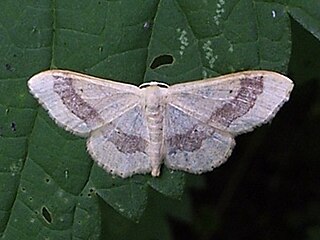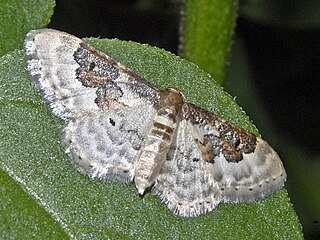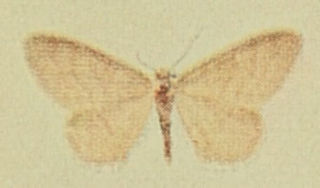
The small fan-footed wave is a moth of the family Geometridae. The species was first described by Johann Siegfried Hufnagel in 1767.

The riband wave is a moth of the family Geometridae. The species was first described by Carl Linnaeus in his 1758 10th edition of Systema Naturae.

The slender pug is a moth of the family Geometridae. It was first described by Jacob Hübner in 1813 and is found throughout Europe and western parts of the Palearctic. The larva feeds on the catkins of willow.

The mottled pug is a moth of the family Geometridae. The species was first described by Jacob Hübner in 1813. It is found across the Palearctic region apart from around the Mediterranean Sea. It is common in the British Isles apart from Scotland where it is rather local.

The common pug is a moth of the family Geometridae. It is a common species across the Palearctic region, including the Near East and North Africa. It ranges from the Atlantic coast of Ireland and Portugal across Europe, the Middle East and Central Asia to the Russian Far East (Priamurje) and Korea.

The juniper pug or juniper looper is a moth of the family Geometridae. The species was first described by Michael Denis and Ignaz Schiffermüller in 1775. It is found throughout the Palearctic and in the Nearctic.

Idaea dimidiata, the single-dotted wave, is a moth of the family Geometridae. It is a Holarctic species.

Idaea muricata, the purple-bordered gold, is a moth of the family Geometridae. It was first described by Johann Siegfried Hufnagel in 1767 and is found in the Palearctic.

Idaea rusticata, the least carpet, is a moth of the family Geometridae. The species was first described by Michael Denis and Ignaz Schiffermüller in 1775.

The brindled pug is a moth of the family Geometridae found in Europe including the British Isles as well as further east to the Baltic States, Armenia, Turkey and the Caucasus. South it reaches North Africa.

Epione repandaria, the bordered beauty, is a moth of the family Geometridae.

Macaria notata, the peacock moth, is a moth of the family Geometridae. It is a Holarctic species.

Idaea fuscovenosa, the dwarf cream wave, is a moth of the family Geometridae. It is found in the Palearctic.

Idaea straminata, the plain wave, is a moth of the family Geometridae. It is found in Europe including West Russia and Balkans.

Idaea subsericeata, the satin wave, is a moth of the family Geometridae. The species was first described by Adrian Hardy Haworth in 1809. It is found from central and southern Europe, North Africa, Asia Minor to Transcaspia.

Idaea dilutaria, also called the silky wave, is a moth of the family Geometridae. It is found in Europe.

The cloaked pug is a moth of the family Geometridae. The species was first described by Johann August Ephraim Goeze in 1781 and it can be found in Europe and to the east in Siberia and Japan.

Eupithecia tripunctaria, the white-spotted pug, is a moth of the family Geometridae. The species can be found from Europe to Korea and Japan and in North America.

Eupithecia trisignaria, the triple-spotted pug, is a moth of the family Geometridae. It is found from across the Palearctic realm from Europe to Siberia.

Idaea flaveolaria is a moth of the family Geometridae first described by Jacob Hübner in 1809.




















